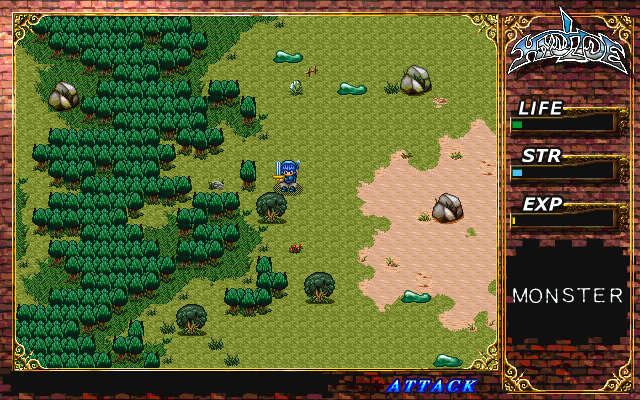The Legend of Zelda was a breakout moment for action role-playing games. The 1986 classic featured a giant world to explore, an item system that continually made the player feel more powerful as the game went on, and a satisfying gameplay loop of exploring the world while then battling in dungeons. A lot of these gameplay ideas are openly credited to Zelda, but another Japanese title called Hydlide had done similar things a few years prior.
Mainly developed by T&E Soft designer Tokohiro Naito, Hydlide shares many similarities with early Apple II role-playing games such as Ultima and Wizardy. However, Naito wasn’t aware of these Western releases, and only knew of Japanese-developed titles such as Dragon Slayer (which was being made during the same time) and Namco’s arcade RPG hit The Tower of Druaga. So, when it released in 1984 for computers, Japanese players were wowed by the innovative RPG that had pushed the medium forward.
However, the reputation couldn’t be any different overseas. By the time Hydlide was released in North America in 1989, it was starting to show its age. What was revolutionary five years prior had been further refined by games like Nintendo’s The Legend of Zelda, and it seemed quite limited by comparison. Throw in some awful background music that played on a loop in the NES port, and it became a regular joke within gaming circles. It was being laughed at rather than being recognized for all of its design triumphs.
What Made Hydlide Important

While the North American reception to Hydlide is understandable given the circumstances, it’s quite an impressive game from a historical viewpoint. It was one of the first action RPGs to be released and added an element of progression to its rudimentary combat. By featuring different gear and weaponry to equip, players had more choices than ever before when it came to how they influenced the gameplay. It also was one of the first games to feature regenerating health, as standing still would slowly refill both magic and life.
Hydlide was one of the earliest examples of an open world. While many games up to that point had been incredibly linear, players had an entire fantasy setting to explore filled with dangerous slimes, skeletons, and all sort of creatures. Danger was constantly lurking about, but so were plenty of rewards so exploration was rewarded handsomely.
Unlocking an item in one dungeon that would then be used in the next might be a commonplace thing now but was fresh back when Hydlide did it. For example, the vampire boss is nearly impossible to be hit without equipping the crucifix that players find in the introductory graveyard. These would later be staples of the Zelda series as a wide range of weaponry would be introduced and then used shortly afterwards to solve puzzles.
The Lasting Legacy of Hydlide

Despite the late NES port giving Hydlide a bad reputation in the West, it was a highly successful series in Japan. A sequel called Shine of Darkness came out in 1985, and was one of the first games to make players consider the morality of their actions. Actions had consequence and as evil players would get ignored in otherwise helpful towns. Hydlide 3: The Space Memories came out in 1987, and it went even further with new mechanics as it added an in-game clock. This would be the second game in the series to come overseas, as it was ported to Sega Genesis as Super Hydlide in 1990.
The last major attempt at giving Hydlide the recognition it deserved came in an ill-fated remake for the Sega Saturn. As seen in the picture above, Virtual Hydlide used sprites to create a rudimentary 3D version of the role-playing game. However, the frame rate was hilariously low, and it’s largely considered one of the ugliest games to ever grace a major gaming system (although Next Generation magazine called it “visually stunning” at the time). It’s hard not to get motion sick from watching gameplay, and while the core design holds up, everything feels extremely stiff and frustrating to play.
It’s really too bad that T&E Soft’s contributions to gaming history will only be known by those that choose to dig deep. However, the series’ impact on the Japanese game development scene is undeniable. Not only did the original go on to set the framework that games like Zelda would go on to improve upon, but the sequels introduced a lot of hardcore simulation elements (such as needing to eat and sleep and a 24-hour clock) that would go on to become more commonplace in the decades that followed. Despite not being known by a large number of players today, Hydlide will forever be an important game that changed the course of gaming history.











